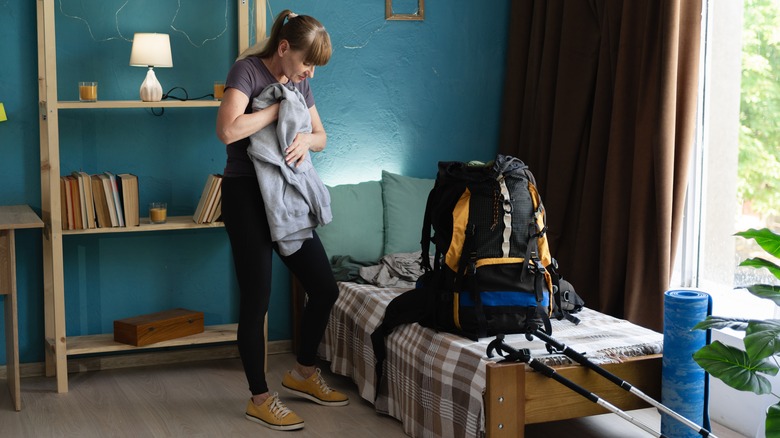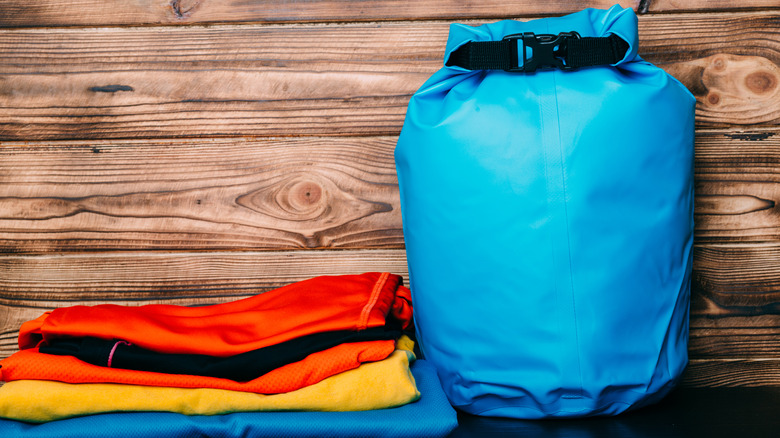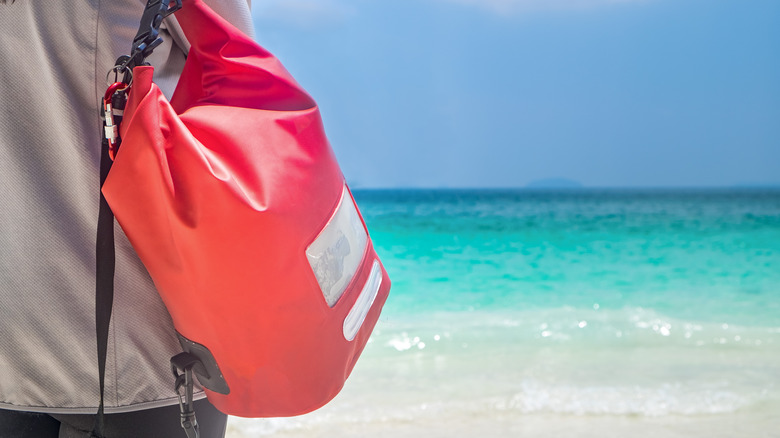This Versatile Camping Item Is A Game Changer For Travel That Trumps Regular Packing Cubes
We may receive a commission on purchases made from links.
If packing a suitcase is an art, then packing cubes are the artist's handiest tool. Unzip your cubes, then place your carefully folded garments into each one. Each unit may be sized and shaped a little differently, and you can sort by shirts, trousers, knits, or whatever other category make sense. Not only can you quickly track down the clothes you want to wear, but a cube's distinctive shape usually keeps your wearables smooth and wrinkle-free. The cubes are usually solid synthetic material on one side, while the opposite wall is made from mesh, so your clothing can breathe. It's hard to pinpoint exactly when packing cubes burst onto the scene or who popularized them, but today, many travelers swear by these floppy little bricks.
Yet backpacking is a different story. Unlike a suitcase, a backpack doesn't come together at 90 degree angles. Among hikers, backpacks are generally shaped like tubes, with rounded sides and a deep interior. There's almost always an opening at the top — and often another at the bottom, for easy access — but instead of stacking clothes inside, outdoorspeople stuff their layers into the backpack like a Thanksgiving turkey. The process and geometry are completely different from a suitcase, so packing cubes don't really fit. The mesh makes cubes vulnerable to woodland debris, so you can't easily set them on the ground, and few cubes are waterproof. There are many things you need to pack to keep camping messes tidy; packing cubes aren't one of them.
The solution is simple and smile-inducing: dry bags. Fundamentally designed for boaters, the dry bag is a waterproof sack that rolls up and clips together on one end; properly sealed, this airtight container can often float on the surface of the water, despite being packed with clothes. They're a kayaking staple, and they're a savvy option for campers, as well.
How to organize and pack your dry bags
What makes them "dry" bags? These units are almost always made of synthetic materials and covered in a protective coating. Backpackers may not care what their bags are made of — PVC or polyurethane — but it's important to know whether your bag is water resistant or waterproof; some bags can prevent a single drop of water from entering, even when submerged in a lake or stream, while others will only wick away rain or general moisture. Dry bags are surprisingly diverse, and you can select for thickness, rigidity, and weight. By extension, the price tags for dry bags are all over the place, from the dirt cheap (about $20 for a whole set on Amazon) to the shockingly expensive (hundreds of dollars for a single unit on Amazon).
Unlike more conventional travel, hikers and campers don't tend to worry much about their appearance, so you can fold, roll, or crush your garments into a dry bag with impunity. The range of sizes should fit any kind of clothing, but you can easily swap one bag for another. The items you store aren't limited to clothes; you can put just about anything into a dry bag, including keys, wallets, and electronics. The bags themselves are light and easy to pack down, so once they're emptied, you can lay a bunch of dry bags flat. They remain handy in almost any climate, from snowy mountains to bone-dry deserts, and they're especially important in places that might get rainy or flooded. Dry bags are durable, but if you use them a lot, it's smart to test them out before you set out; in general, this is something you should always do before camping trips to avoid less useful gear.
Using dry bags for laundry
Dry bags come with one more surprising benefit: They're useful for washing clothes. They already make great laundry bags for smelly clothes, so you can keep them separate from your clean sets. Then, if you don't have access to a washing machine on the road, you can pour in some water and sprinkle some detergent. Knead it with your hands and drain the dirty water periodically. Rinse out the soap, remove your clothes from the bag, and hang them up to air dry. Try doing that with a packing cube.
This technique is ideal for multi-day hikes, and you may consider using dry bags for laundry on, say, the Appalachian Trail. Budget travelers may also use it for regular travel, when laundromats are hard to find or too inconvenient. This is one of the most practical ways to do laundry when traveling, and once you're finished scrubbing, you can just turn the bag inside out. Not surprisingly, it shouldn't take to long to dry.


